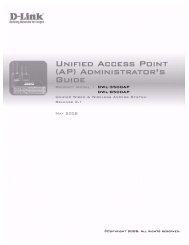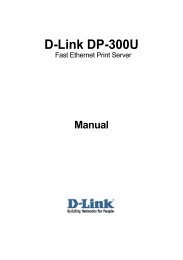Product Manual
Product Manual
Product Manual
Create successful ePaper yourself
Turn your PDF publications into a flip-book with our unique Google optimized e-Paper software.
DES-3526 / DES-3526DC Fast Ethernet Layer 2 Switch<br />
dropped. If it has the same VID, the packet is forwarded and the destination port transmits it on its<br />
attached network segment.<br />
This process is referred to as ingress filtering and is used to conserve bandwidth within the Switch by<br />
dropping packets that are not on the same VLAN as the ingress port at the point of reception. This<br />
eliminates the subsequent processing of packets that will just be dropped by the destination port.<br />
Default VLANs<br />
The Switch initially configures one VLAN, VID = 1, called "default." The factory default setting<br />
assigns all ports on the Switch to the "default." As new VLANs are configured in Port-based mode,<br />
their respective member ports are removed from the "default."<br />
Packets cannot cross VLANs. If a member of one VLAN wants to connect to another VLAN, the link<br />
must be through an external router.<br />
NOTE: If no VLANs are configured on the Switch, then all packets will be<br />
forwarded to any destination port. Packets with unknown source addresses<br />
will be flooded to all ports. Broadcast and multicast packets will also be<br />
flooded to all ports.<br />
An example is presented below:<br />
Port-based VLANs<br />
VLAN Name VID Switch Ports<br />
System (default) 1 5, 6, 7, 8, 21, 22, 23, 24<br />
Engineering 2 9, 10, 11, 12<br />
Marketing 3 13, 14, 15, 16<br />
Finance 4 17, 18, 19, 20<br />
Sales 5 1, 2, 3, 4<br />
Table 6- 2. VLAN Example - Assigned Ports<br />
Port-based VLANs limit traffic that flows into and out of switch ports. Thus, all devices connected to<br />
a port are members of the VLAN(s) the port belongs to, whether there is a single computer directly<br />
connected to a switch, or an entire department.<br />
On port-based VLANs, NICs do not need to be able to identify 802.1Q tags in packet headers. NICs<br />
send and receive normal Ethernet packets. If the packet's destination lies on the same segment,<br />
communications take place using normal Ethernet protocols. Even though this is always the case,<br />
when the destination for a packet lies on another switch port, VLAN considerations come into play to<br />
decide if the packet gets dropped by the Switch or delivered.<br />
VLAN Segmentation<br />
Take for example a packet that is transmitted by a machine on Port 1 that is a member of VLAN 2. If<br />
the destination lies on another port (found through a normal forwarding table lookup), the Switch then<br />
looks to see if the other port (Port 10) is a member of VLAN 2 (and can therefore receive VLAN 2<br />
packets). If Port 10 is not a member of VLAN 2, then the packet will be dropped by the Switch and<br />
will not reach its destination. If Port 10 is a member of VLAN 2, the packet will go through. This<br />
selective forwarding feature based on VLAN criteria is how VLANs segment networks. The key point<br />
being that Port 1 will only transmit on VLAN 2.<br />
64

















